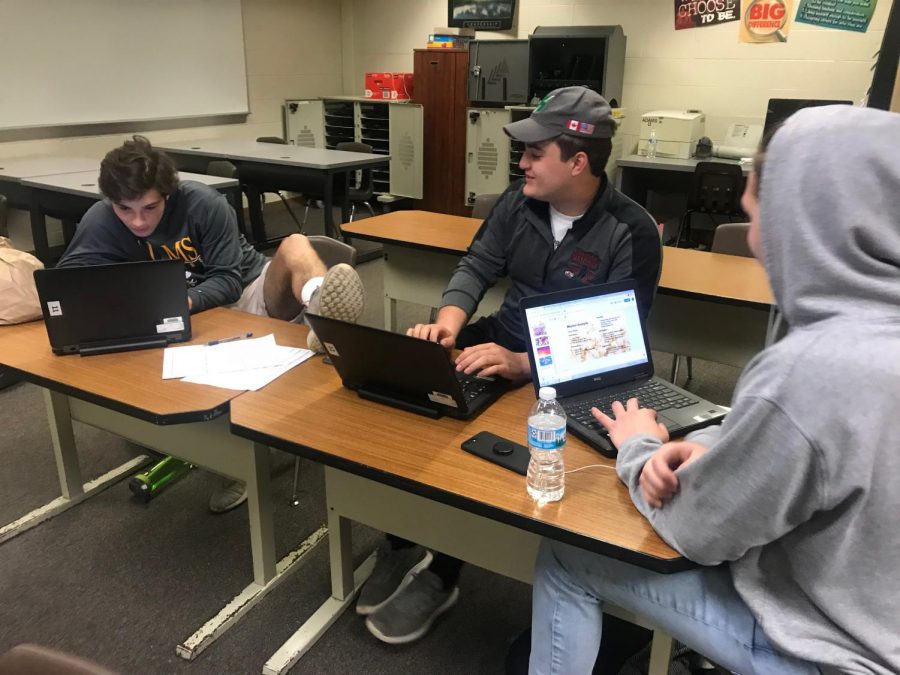BYOD: Fail or Holy Grail?
Juniors Carlo Munaco and Domenico Munaco and senior Christian Vataj in their Advanced Marketing and Advertising class utilizing their school-provided technology.
The Rochester Community Schools Curriculum is considering adopting a “Bring Your Own Device”, or BYOD, program for high school students beginning in the 2018-2019 school year. The BYOD policy would allow students to bring in their own devices, such as laptops, to use in their classrooms.
Carrie Lawler, Executive Director of Secondary Education at RCS, sent the following email out to Rochester parents:
“The RCS Curriculum Department is considering adopting a ‘Bring Your Own Device’ program for High School students. It would be very helpful for the curriculum department to obtain feedback from parents about how this might impact both families and classroom instruction. Please take a moment to click on the link below to take a short survey regarding the BYOD program,” said Lawler.
The email included a link for parents to visit to offer feedback on the potential integration of the program.

“The parent survey showed that parents generally support the idea. With 850 parents answering the survey, 62 percent said they’d be willing to supply a device, 16 percent said that they would supply a device in the future, but next year is too soon, and 23 percent said no. Many parents indicated that they need more information,” said Lawler.
The idea for the program stemmed from the need to update the curriculum and relevance of courses as a secondary curriculum department across Rochester Community Schools. A band composed of curriculum consultants from each core subject, including Lawler, worked together to compose ideas to move forward as an educational institution. Lawler also met with parent groups, and the principal and technology departments of RCS high schools to draft potential language and possibilities to be implemented.
Department heads looked at schools already involved in the BYOD program including Bloomfield Hills High School, Northville High School, and Walled Lake High School. Teachers are often faced with the issue of having to reserve a block of time for a computer lab, media center, or laptop cart weeks in advance, and the BYOD program offers a solution. Kids would be able to learn anywhere with no downtime, no schedule, and no access restrictions.
“We want teachers to be able to take advantage of ‘teachable moments’ and we want students to have a realistic and timely connection to information and programs,” said Lawler.
The students of today are digital natives living in a multimedia world and prioritize visual learning with immediate connection and collaboration. BYOD can be used as a way to increase access to technology by offsetting the need to purchase a device for each student, however there are a number of other costs that must be considered if RCS is to implement a BYOD policy. For example, schools’ network infrastructure may need to be updated in order to ensure students will have fast and reliable internet connection at all times.
Many may be concerned about the ability for some to provide a device to engage in the program. Lawler suggests a few potential solutions including: Providing a device from the district for students who qualify for free or reduced priced lunch, or finding low-cost devices through partnership with local providers for families to purchase.
Even so, some questions are still left unanswered. What if a student forgets or breaks their device? Additionally, none of Rochester’s schools are designed with charging stations, which presents yet another inconvenient issue students and faculty may be faced with. If charging stations are installed, schools’ energy bills may be significantly impacted as well.
Budget cuts in the education system have made it increasingly difficult to purchase new technology, and repair pre-existing devices for school-wide use. However, is it fair to ask students and their families to make up for lack of funding in their school’s technology departments? There is a vast variety of devices available on the market today. Therefore, it is impossible to assume every teacher and administrator will be backed with the proper training and resources needed to help their students adequately learn from and work with their new devices, especially if money is a preceding issue.
“Without proper planning, implementation and professional development, BYOD may not work as people had hoped. And guess what? The teacher will probably get blamed. It’s not fair that schools invite students to bring these devices and expect student achievement to improve just because these technologies are in the classroom,” said associate director of the National Education Association’s education policy and practice department, Andrea Prejean.
On the other hand, some may feel the benefits outweigh the potential drawbacks. For example, students will have the opportunity to take advantage of their own devices they are comfortable with. Additionally, because the majority of devices used in the BYOD program are parent-funded, schools will be able to put the money saved toward funding for other programs and technologies.
With readily available technology at the fingertips of students, teachers will be able to lesson plan effectively and be more actively relevant in 21st century learning. The BYOD program replicates the technology-rich environment many young-adults are already immersed in outside of and beyond their high school careers.
Allowing students to utilize their own devices in school to embrace digital learning is a critical takeoff from the stereotypical “cellphone ban” ideal many schools have become accustomed to. Perhaps education providers need to get with the times and adopt a policy, such as BYOD, to avoid falling behind in today’s rapidly developing technosphere.







